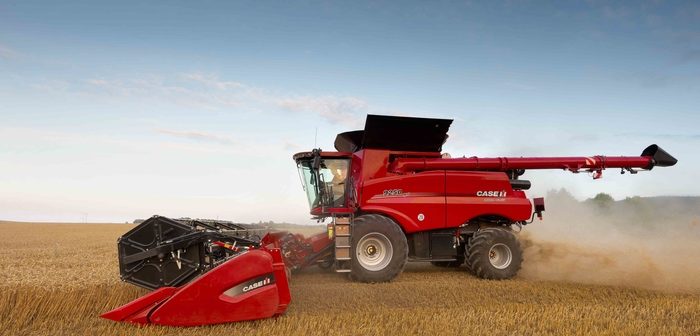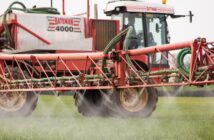New models replace 240 series as flagship combines for 2019 / AFS Harvest Command™ automation minimises losses and grain damage, maximises output / Feedrate control system adapts key machine elements to crop volume / Grain camera continuously analyses quality / Sieve pressure sensor technology and auto fan speed maintain ideal pressure as conditions change
Featuring a number of new automated features designed to allow operators to more easily maximise machine performance in terms of crop throughput and quality, Case IH is launching three new 250 series Axial-Flow combines for 2019, replacing the existing 7240, 8240 and 9240 models.
“The 250 series Axial-Flow upgrades focus on improving both combine and operator productivity,” explains August von Eckardstein, Case IH harvesting product marketing manager for Europe, Middle East and Africa.
“Our aim has been to aid decision-making and make front-to-rear settings easier for a particular desired outcome. In this way, the combine can not only help to enhance an experienced operator’s performance, but can also help a less-experienced one to quickly gain confidence and get the most from the machine.”
New AFS Harvest Command™ automation
At the heart of the changes for the new 7250, 8250 and 9250 Axial-Flow combines is AFS Harvest Command™ automation. This completely new technology package utilises sixteen sensor inputs to continuously monitor the machine, and adjusts seven different settings to maximise combine performance. Managed through the in-cab AFS Pro700 terminal, the automation system is currently capable of working in wheat, oilseed rape/canola, corn/maize and soybeans. Just a few selections according to crop type and conditions allow the operator to set the machine to perform to a desired outcome.
The basic version of AFS Harvest Command™ features the proven Automatic Crop Settings (ACS) system. This adjusts operating items such as fan speed and concave clearance according to the crop type selected on the AFS terminal screen, eliminating the need to make individual element settings. The operator is able to adjust the combine on the go and save the settings for future use.
The next version, with Feedrate Control, adjusts ground speed based on crop load to cater for a desired outcome – performance to control losses, maximum throughput, or fixed throughput. The operator sets the target maximum engine load and ground speed, and Feedrate Control will operate up to those limits. The new Feedrate Control system more accurately controls ground speed based on crop and ground drive load. Feedrate Control, which can be used as a stand-alone function, works in all crop types.
The top specification option is full AFS Harvest Command™ automation, which automatically makes threshing and cleaning system adjustments based on the same desired outcomes as Feedrate Control, with the addition of grain quality monitoring. This uses camera-based technology and sieve pressure sensing to provide further guidance to the machine’s automatic adjustment process to minimise impurities in the grain sample and maintain the best grain quality, a trait for which the Axial-Flow combine has earned its reputation.
“The AFS Harvest Command™ automation grain camera utilises a patented multi-spectral light emission – visible and invisible – to more accurately identify broken grains and impurities,” says August von Eckardstein.
“This patented technology helps the grain camera more accurately monitor sample quality, illuminating it with UV, blue, green, red and infra-red light. Combining the five light spectrums provides enhanced detection of the exposed starch in broken grains. The AFS terminal alerts the operator if dirt affects camera clarity.”
With full automation, AFS Harvest Command™ can be used in four different ways. In all cases, the operator sets a maximum target engine load and maximum ground speed for the combine to then operate in:
- Performance mode: the combine operates at a speed to ensure an acceptable level of grain loss from the rotor and cleaning system.
- Fixed Throughput mode: the combine maintains a target throughput by varying its speed, and adjusts settings to minimise losses.
- Maximum Throughput mode: the combine operates up to the speed or power limit set by the operator, while adjusting settings to minimise grain loss from the rotor and the cleaning system.
- Grain quality mode: the combine adjusts settings to maintain a targeted grain quality and impurity level, while also minimising losses.
After selecting the ‘Basic’ tab on the AFS screen, the operator enters crop type, desired outcome/strategy, maximum ground speed and maximum engine load. The system is then engaged and harvesting begins. Fine-tuning is possible via an Advanced tab that allows, for example, initial start-off settings to be altered, the frequency of automatic alterations to be adjusted, and ease of threshing to be accounted for.
“AFS Harvest Command™ automation is not designed to replace operator decisions, but to enhance them, identifying the factor limiting combine performance as conditions change, displaying it and making adjustments to address it,” says August von Eckardstein.
“Experienced operators can further enhance output and grain quality, and inexperienced ones can more quickly achieve productivity comparable to an experienced operator. For both, AFS Harvest Command™ means less need to worry about factors such as losses, fan speed and rotor speed, which allows greater focus on header position and unloading.”




